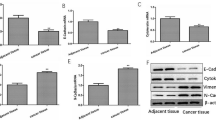Abstract
Background
MiRNAs belong to non-coding RNAs that are involved in cancer development. Acting as a mediator, they could regulate the expression level of numerous gens. However, the expression and function of miR-1299 in gastric cancer (GC) are not clear.
Objective
To explore the role of miR-1299 in the process of GC.
Methods
We detected the levels of miR-1299 in clinical samples of GC and investigated the role of miR-1299 in the regulation of the GC cells proliferation, apoptosis and metastasis. Luciferase reporter assay was employed to verify the target of miR-1299. Additionally, the proliferation, apoptosis and metastasis of AGS and SGC7901 cells were analyzed after the overexpression of miR-1299.
Results
Our study showed the expression of miR-1299 was decreased in GC tissues and cell lines. It indicated that the cell proliferation, migration and invasion was inhibited, while the cell apoptosis was promoted by the over-expressed miR-1299. Also, we found that miR-1299 could directly target the 3′-untranslated region (3′UTR) of ARF6 genes. In addition, rescue assay demonstrated that miR-1299 overexpression promoted the cell apoptosis and inhibited cell growth, which could be attenuated by the overexpression of ARF6.
Conclusions
These findings indicate that miR-1299 regulates cell progression in GC by targeting ARF6 genes, and suggest that miR-1299 may be a tumor suppressor in the GC progression.





Similar content being viewed by others
References
Aravalli RN, Steer CJ, Cressman EN (2008) Molecular mechanisms of hepatocellular carcinoma. Hepatology 48:2047–2063
Bartel DP (2004) MicroRNAs: genomics, biogenesis, mechanism, and function. Cell 116:281–297
Budhu A, Jia HL, Forgues M, Liu CG, Goldstein D, Lam A, Zanetti KA, Ye QH, Qin LX, Croce CM et al (2008) Identification of metastasis-related microRNAs in hepatocellular carcinoma. Hepatology 47:897–907
Calin GA, Croce CM (2006) MicroRNA signatures in human cancers. Nat Rev Cancer 6:857–866
Ding L, Wang L, Li Z, Jiang X, Xu Y, Han N (2020) The positive feedback loop of RHPN1-AS1/miR-1299/ETS1 accelerates the deterioration of gastric cancer. Biomed Pharmacother 124:109848
Dumas M (2013) The effect of microRNA-31 on the small GTPase Arf6 and the role of Arf6 in early embryogenesis. University of Delaware
Eades G, Wolfson B, Zhang Y, Li Q, Yao Y, Zhou Q (2015) LincRNA-RoR and miR-145 regulate invasion in triple-negative breast cancer via targeting ARF6. Mol Cancer Res 13:330–338
Feng R, Chen X, Yu Y, Su L, Yu B, Li J, Cai Q, Yan M, Liu B, Zhu Z (2010) MiR-126 functions as a tumour suppressor in human gastric cancer. Cancer Lett 298:50–63
Gao FY, Liu QY, Yuan L, Xuan SY (2015) Upregulation of microRNA-132 in gastric cancer promotes cell proliferation via retinoblastoma 1 targeting. Mol Med Rep 12:7005–7010
Hsu WC, Li WM, Lee YC, Huang AM, Chang LL, Lin HH, Wu WJ, Li CC, Liang PI, Ke HL (2020) MicroRNA-145 suppresses cell migration and invasion in upper tract urothelial carcinoma by targeting ARF6. FASEB J 34(4):5975–5992
Jiang Y, Ajani JA (2010) Multidisciplinary management of gastric cancer. Curr Opin Gastroenterol 26:640–646
Lang Q, Ling C (2012) MiR-124 suppresses cell proliferation in hepatocellular carcinoma by targeting PIK3CA. Biochem Biophys Res Commun 426:247–252
Lee YS, Dutta A (2006) MicroRNAs: small but potent oncogenes or tumor suppressors. Curr Opin Investig Drugs 7:560–564
Li Z, Ying X, Chen H, Ye P, Shen Y, Pan W, Zhang L (2014) MicroRNA-194 inhibits the epithelial-mesenchymal transition in gastric cancer cells by targeting FoxM1. Dig Dis Sci 59:2145–2152
Lin L, Cai J (2020) Circular RNA circ-EGLN3 promotes renal cell carcinoma proliferation and aggressiveness via miR-1299-mediated IRF7 activation. J Cell Biochem 121:4377–4385
Yao Y, Suo AL, Li ZF, Liu LY, Tian T, Ni L, Zhang WG, Nan KJ, Song TS, Huang C (2009) MicroRNA profiling of human gastric cancer. Mol Med Rep 2:963–970
Yasui W, Sentani K, Sakamoto N, Anami K, Naito Y, Oue N (2011) Molecular pathology of gastric cancer: research and practice. Pathol Res Pract 207:608–612
Yu X, Song H, Xia T, Han S, Xiao B, Luo L, Xi Y, Guo J (2013) Growth inhibitory effects of three miR-129 family members on gastric cancer. Gene 532:87–93
Yu Q, Dai J, Shu M (2020) Hsa_circ_0003645 shows an oncogenic role by sponging microRNA-1299 in hepatocellular carcinoma cells. J Clin Lab Anal 34:e23249
Zhu H, Wang G, Zhou X, Song X, Gao H, Ma C, Chang H, Li H, Liu FF, Lu J et al (2016) MiR-1299 suppresses cell proliferation of hepatocellular carcinoma (HCC) by targeting CDK6. Biomed Pharmacother 83:792–797
Acknowledgements
We wish to thank the editor, the associate editor, and the three anonymous reviewers for their helpful comments and suggestions, which have led to an improvement of this article.
Author information
Authors and Affiliations
Corresponding author
Ethics declarations
Conflict of interest
Yang Qiu, Yonggang Yuan and Ping Luo declare that they have no conflict of interest.
Ethical approval
This study had been approved by the Medical Ethics Committee of Jiangxi Cancer Hospital (No. 2020ky175). Informed consent was obtained from all individual participants included in the study.
Additional information
Publisher’s Note
Springer Nature remains neutral with regard to jurisdictional claims in published maps and institutional affiliations.
Rights and permissions
About this article
Cite this article
Qiu, Y., Yuan, Y. & Luo, P. MiR-1299 functions as a tumor suppressor to inhibit the proliferation and metastasis of gastric cancer by targeting ARF6. Genes Genom 44, 237–245 (2022). https://doi.org/10.1007/s13258-021-01124-w
Received:
Accepted:
Published:
Issue Date:
DOI: https://doi.org/10.1007/s13258-021-01124-w




